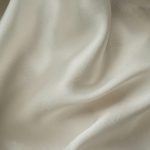To remove ketchup or tomato sauce stains from your upholstery, first identify the fabric type by checking labels or doing a burn test. Act quickly by blotting the stain gently with a clean cloth and cold water—don’t rub. Use a mild detergent solution and work from the stain’s edge inward. For stubborn stains, consider a commercial upholstery cleaner made for your fabric. After cleaning, let it air dry fully. Keep exploring for more effective methods and prevention tips.
Table of Contents
Key Takeaways
- Blot ketchup stains gently with a clean cloth immediately, avoiding rubbing to prevent spreading.
- Use cold water and a mild detergent solution to dab and lift the stain from the upholstery.
- Work from the outside of the stain inward to avoid enlarging the affected area.
- For stubborn or old stains, apply a commercial upholstery cleaner compatible with the fabric type.
- Allow upholstery to air dry completely and vacuum gently to restore texture after cleaning.
Identifying the Type of Upholstery Fabric
How do you know what kind of fabric your upholstery is made from? Start by checking the manufacturer’s tag, usually hidden under cushions or on the underside of the furniture. This tag often lists the fabric type and care instructions.
Check the manufacturer’s tag under cushions or furniture underside to identify fabric type and care instructions.
If you can’t find a label, examine the texture and weave closely. Natural fibers like cotton and linen feel softer and breathe more, while synthetic fabrics like polyester or nylon often feel smoother and more durable.
You can also perform a burn test on a small, hidden thread: natural fibers burn differently than synthetics, but be cautious with this method.
Knowing the fabric type is essential because it determines which cleaning methods and products are safe to use, protecting your upholstery from damage while effectively tackling ketchup stains.
Immediate Actions to Take After a Spill
As soon as ketchup spills on your upholstery, you need to act fast to prevent it from setting.
Start by gently blotting the stain with a clean cloth—never rub, as that can push the stain deeper.
Then, use cold water to help lift the ketchup without causing damage.
Blot, Don’t Rub
When ketchup spills on your upholstery, you’ve got seconds to act before the stain sets. The key is to blot the spill gently with a clean cloth or paper towel.
Don’t rub—the motion only pushes the ketchup deeper into the fabric fibers, making the stain worse. Press down lightly to absorb as much liquid as possible.
Use fresh sections of your cloth as it soaks up the ketchup to avoid spreading the stain. Blotting lifts the excess sauce without grinding it in, giving you a better chance to remove the stain completely later.
Stay patient and resist the urge to scrub; a careful blot is your best first defense against a stubborn ketchup stain.
Use Cold Water
Although blotting helps remove the excess ketchup, you’ll need cold water to prevent the stain from setting.
Grab a clean cloth or sponge, dampen it with cold water, and gently dab the stained area. Avoid using warm or hot water, as it can cause the tomato stain to bond with the fabric fibers, making it harder to remove.
Cold water helps loosen the stain without pushing it deeper. Continue blotting with the cold, damp cloth until you see the ketchup lifting. Be careful not to saturate the upholstery; just enough moisture to lift the stain.
Once you’ve treated the area with cold water, you can move on to the next steps to fully remove the stain and restore your upholstery’s appearance.
Act Promptly
If you want to prevent a ketchup stain from setting, act immediately after the spill occurs.
Grab a clean cloth or paper towel and gently blot the excess ketchup—don’t rub, as that will push the stain deeper.
Next, dampen another cloth with cold water and continue blotting to dilute the stain. The quicker you respond, the easier it’ll be to remove.
Avoid using hot water or harsh chemicals right away, as they can fix the stain permanently.
After blotting, you can apply a mild upholstery cleaner or a mixture of dish soap and cold water.
Always test any cleaner on a hidden spot first.
Acting promptly minimizes stain damage and increases your chances of restoring your upholstery to its original condition.
Preparing Cleaning Materials and Solutions
Before you start cleaning, gather essential supplies like a clean cloth, mild detergent, and cold water.
You can also make effective homemade stain removers using common ingredients like vinegar and baking soda.
Having these ready will help you tackle the ketchup stain quickly and efficiently.
Essential Cleaning Supplies
When tackling ketchup stains on upholstery, gathering the right cleaning supplies guarantees you can act quickly and effectively. You’ll want to have everything ready to avoid delays that allow stains to set. Essential items include absorbent cloths, a soft-bristled brush, a spray bottle, and a mild detergent or upholstery cleaner. Having cold water on hand also helps dilute the stain immediately.
| Supply | Purpose | Tip |
|---|---|---|
| Absorbent Cloths | Blot excess ketchup | Use white cloths to avoid color transfer |
| Soft-Bristled Brush | Gently agitate fibers | Avoid harsh scrubbing |
| Spray Bottle | Apply cleaning solution | Use cold water or cleaner diluted |
| Mild Detergent | Break down stain particles | Choose upholstery-safe types |
Homemade Stain Removers
Although commercial cleaners are convenient, you can often tackle ketchup stains effectively using homemade solutions made from simple ingredients found in your kitchen.
Start by mixing one tablespoon of dish soap with two cups of cold water. This gentle solution helps break down the stain without damaging upholstery fibers.
For tougher stains, combine equal parts white vinegar and water in a spray bottle. Vinegar’s acidity lifts stains while deodorizing.
Baking soda is another powerful option; sprinkle it on the dampened stain and let it sit for 10-15 minutes before gently brushing it off.
Always test your homemade cleaner on a hidden fabric spot first to avoid discoloration.
With these easy-to-make solutions, you’ll be ready to remove ketchup stains quickly and safely.
Step-by-Step Stain Removal Process
You’ll need just a few simple steps to tackle ketchup stains on your upholstery effectively.
First, blot the stain gently with a clean cloth or paper towel to absorb excess ketchup—don’t rub, as this spreads the stain.
Next, mix a mild detergent with warm water and dip a sponge into the solution. Dab the stained area carefully, working from the outside toward the center to prevent spreading.
Afterward, rinse the sponge with clean water and blot the area to remove soap residue. Use a dry cloth to absorb moisture, then let the upholstery air dry completely.
If the stain persists, repeat these steps until it fades. Acting quickly and following this process will help restore your upholstery without damage.
Using Homemade Remedies for Stain Removal
If the standard cleaning method doesn’t completely remove the ketchup stain, homemade remedies can offer an effective alternative.
Start by mixing one tablespoon of dish soap with two cups of cold water. Dip a clean cloth into the solution and gently blot the stain without rubbing.
For tougher stains, try a paste of baking soda and water—apply it to the stain, let it sit for 15 minutes, then blot with a damp cloth.
White vinegar diluted with water also works well; mix equal parts and dab onto the stain, then blot dry.
Always test any homemade solution on a hidden area first to avoid discoloration.
These remedies use common household items and can help lift stubborn ketchup stains without harsh chemicals.
When to Use Commercial Upholstery Cleaners
While homemade remedies work well for many ketchup stains, some situations call for commercial upholstery cleaners to achieve the best results. You should reach for these products when stains are old, widespread, or stubborn. Also, if your upholstery is made from delicate fabrics that need specialized care, commercial cleaners offer targeted solutions without damage.
| When to Use Commercial Cleaners | Why It’s Effective |
|---|---|
| Stain is set or old | Formulated to break down tough stains |
| Large or widespread stain | Covers bigger areas efficiently |
| Delicate fabric | Designed for specific materials |
| Previous cleaning failed | Stronger formula for stubborn stains |
| You want quick, guaranteed results | Saves time and effort |
Using commercial cleaners guarantees a thorough, professional clean when homemade methods aren’t enough.
Tips for Preventing Future Stains
Since prevention is often easier than removal, taking proactive steps can save your upholstery from future ketchup stains.
Start by establishing no-eating zones around your furniture to minimize accidental spills. Use stain-resistant fabric treatments or upholstery protectors to create a barrier that repels liquids.
Keep napkins and cleaning wipes handy during meals so you can quickly address any drips before they set. Train kids and guests to handle sauces carefully, and consider using washable slipcovers for added protection.
Regularly vacuum your upholstery to remove dirt and debris that can attract stains.
Caring for Upholstery After Cleaning
After you’ve successfully removed ketchup stains, caring for your upholstery properly guarantees it stays fresh and damage-free.
First, allow the fabric to dry completely in a well-ventilated area to prevent mildew or odors. Next, gently vacuum the fabric to lift any residual dirt and restore its texture. Finally, protect your upholstery by applying a fabric protector spray designed for your material type; this creates a barrier against future spills.
- Avoid direct sunlight to prevent fading and fabric deterioration.
- Rotate cushions regularly to ascertain even wear.
- Address any new stains promptly using appropriate cleaning methods.
Frequently Asked Questions
Can Ketchup Stains Cause Permanent Discoloration on Leather Upholstery?
Yes, ketchup stains can cause permanent discoloration on leather upholstery if you don’t act quickly. You’ll want to clean the stain gently and promptly to prevent it from setting and damaging the leather’s color.
Are Enzyme-Based Cleaners Safe for All Upholstery Fabrics?
Enzyme-based cleaners generally work well, but you shouldn’t assume they’re safe for all upholstery fabrics. Always test a small, hidden spot first to avoid damage, especially on delicate or natural materials like silk or leather.
How Long Should I Wait Before Using a Commercial Cleaner After a Homemade Remedy?
You should wait about 10 to 15 minutes after trying a homemade remedy before using a commercial cleaner. This gives the homemade treatment time to work without causing chemical reactions or fabric damage.
Can Steam Cleaning Effectively Remove Tomato Sauce Stains?
Think of steam cleaning like a hot shower washing away stubborn dirt. Yes, it can effectively remove tomato sauce stains by loosening particles, but you might need to follow up with a stain remover for best results.
Is It Safe to Use Bleach on Upholstery Stains?
You shouldn’t use bleach on upholstery stains because it can damage fabric colors and fibers. Instead, try gentler cleaners or test any product on a hidden spot before applying it widely to keep your upholstery safe.
- Where to Buy Sherpa Suede Fabric - July 12, 2025
- How to Draw or Illustrate the Texture of Suede Fabric - July 12, 2025
- What Is Baseball Suede Leather Fabric? - July 12, 2025







